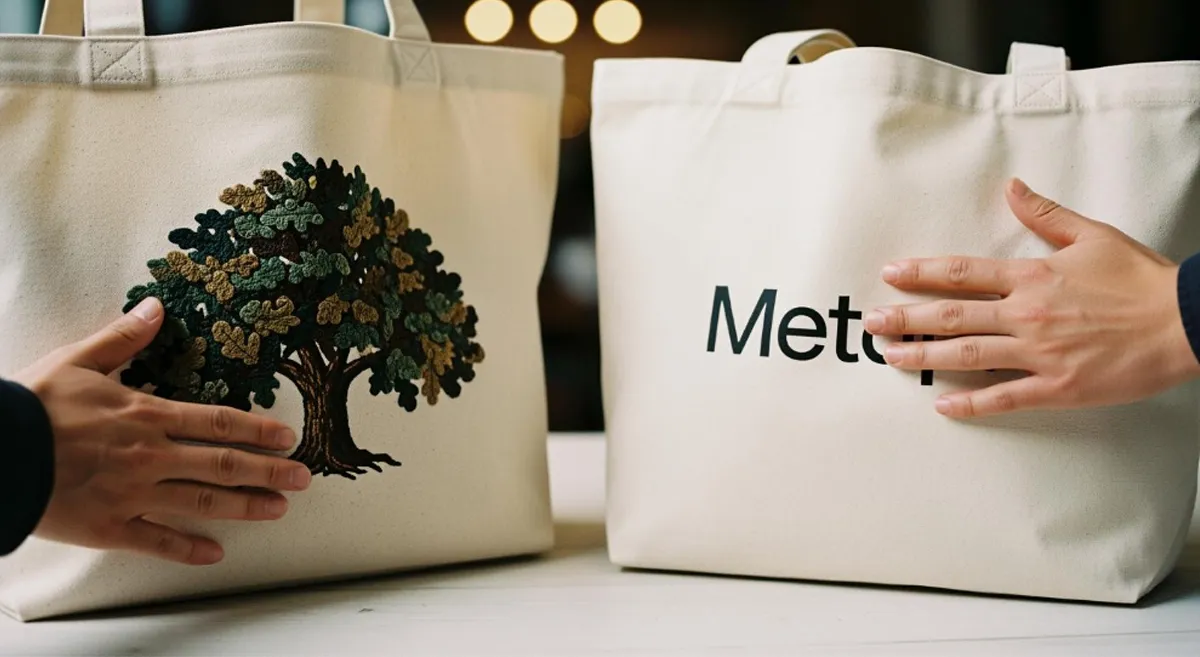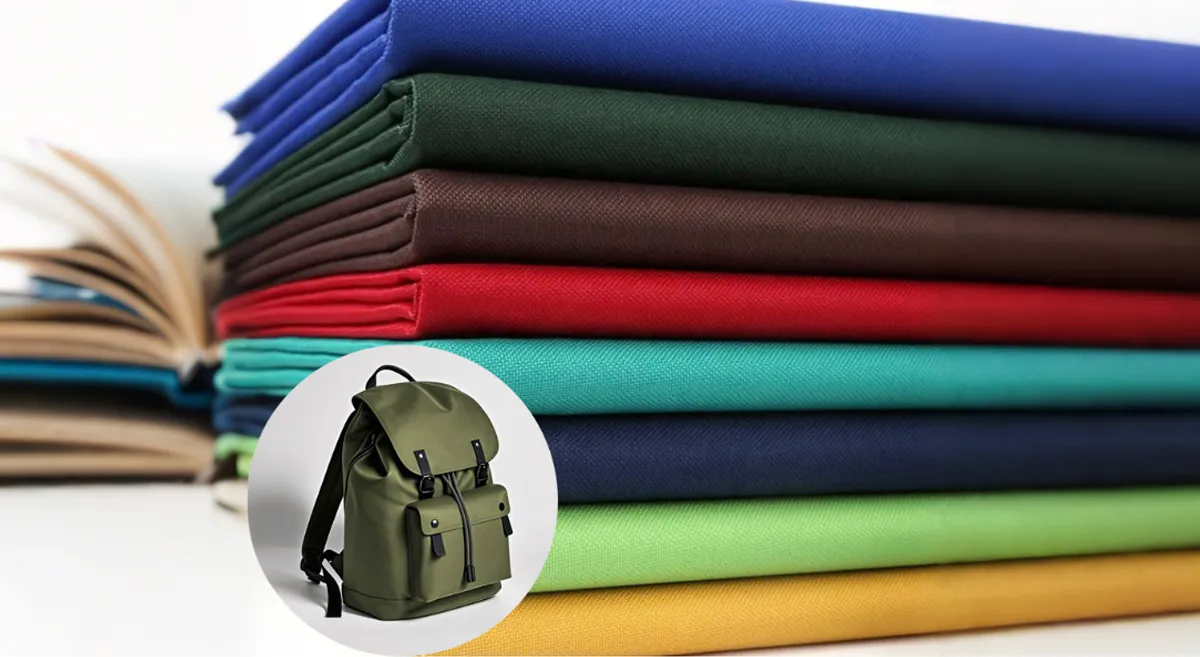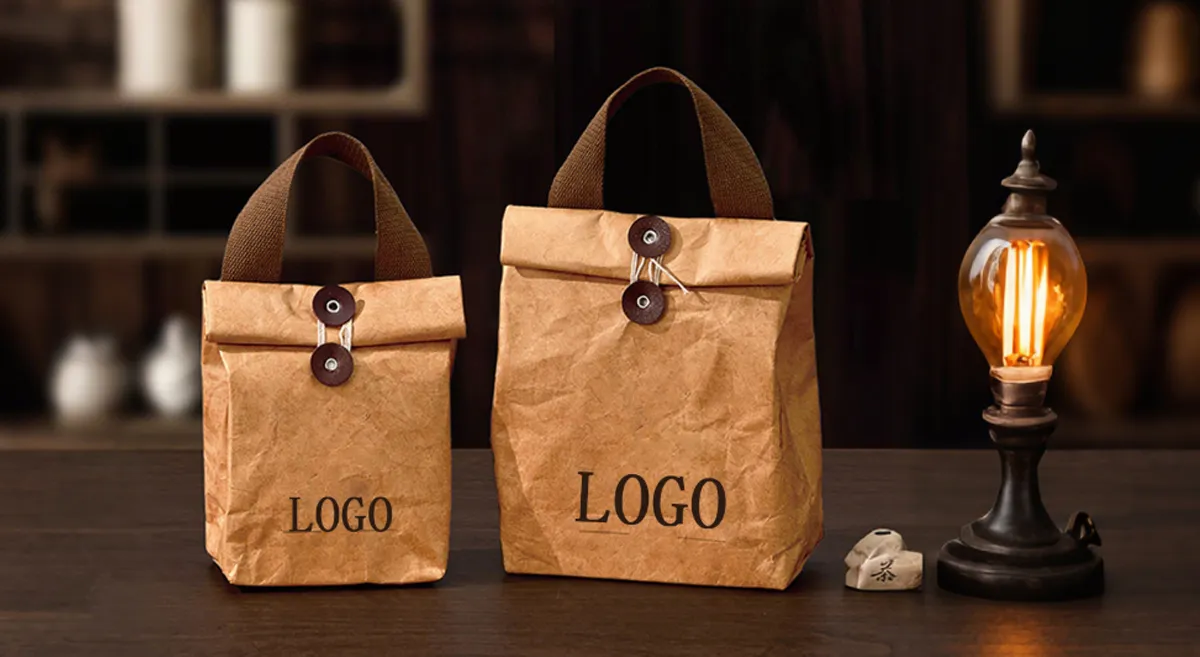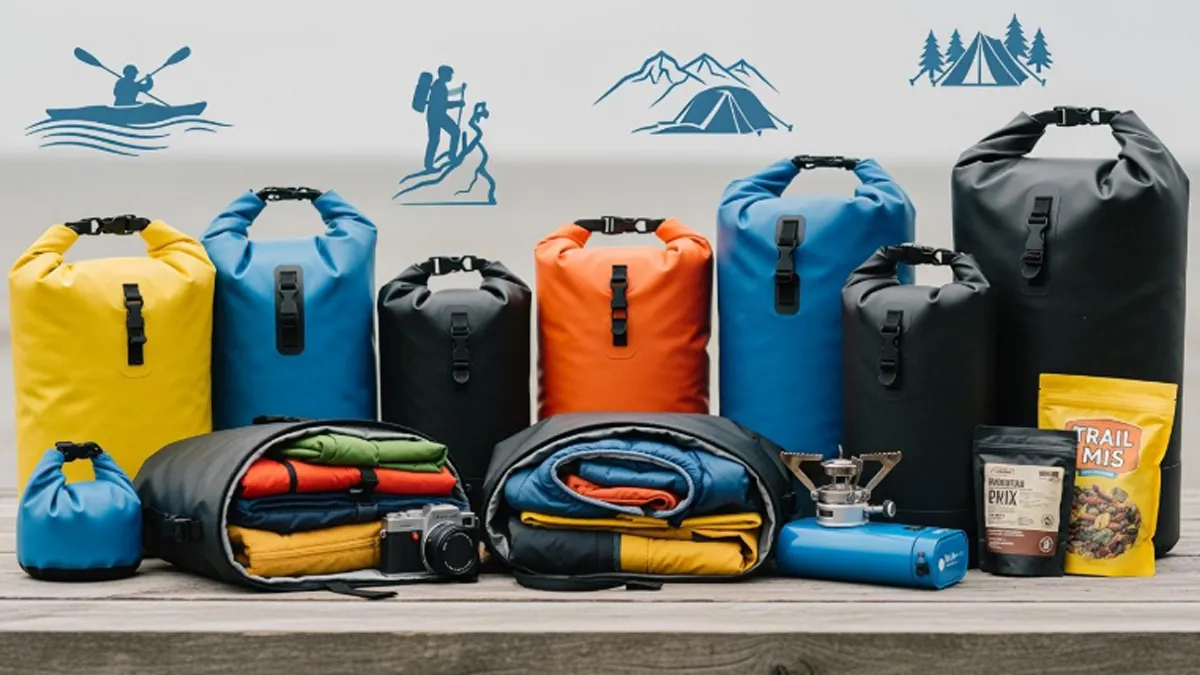
When you look at the different types of dry bags, you’ll see they all protect your gear from water, moisture, and dirt. These bags use tough materials and airtight seals to keep your stuff dry, even if you drop them in a river. Some styles work best for hiking, while others fit kayaking or storing first aid dry bags. The benefits of using dry bags go beyond just keeping things dry—they also keep dust out and make packing easier. If you’re curious about dry bag vs dry sack or want to know which types of dry bags fit your next adventure, you’re in the right place.
Picking the right dry bag style means your gear stays safe, no matter where you go. The benefits of using dry bags depend on matching the bag to your activity.
Key Takeaways
- Dry bags keep your things safe from water and dirt. They are important for outdoor trips.
- Pick the right dry bag for your activity. Use roll-top bags for kayaking. Use zippered bags if you need fast access.
- Check your dry bag’s seal before you use it. Put tissue inside and dip it in water.
- Take care of your dry bag to make it last longer. Clean it and store it the right way.
- Some dry bags, like clamshell and hybrid, have special features. These help you organize and find your things easily.
- Get a dry bag with a strong waterproof rating. This is good for trips where things get wet for a long time.
- Use different colors and sizes of dry bags. This helps you keep your things neat and easy to find.
- Look at your dry bag often for damage. If you see cracks or leaks, get a new dry bag.
What Is a Dry Bag?
Definition & Purpose
You might wonder what makes a dry bag different from any other bag you use outdoors. A dry bag is a waterproof pouch that keeps your gear safe and dry when you’re near water. You’ll find dry bags made from tough, flexible materials like PVC or coated nylon. These materials help block water from getting inside, even if you drop the bag in a river or face heavy rain. Unlike regular backpacks, dry bags don’t have a rigid structure. Their main job is to keep your stuff dry, not to organize it. You can use a dry bag for kayaking, fishing, hiking, or any activity where water is a risk.
Tip: If you plan to spend time on a boat, near a lake, or in rainy weather, a dry bag gives you peace of mind. You won’t have to worry about your phone, clothes, or snacks getting soaked.
Most outdoor gear guides say that dry bags are essential for anyone who wants protection from water. You can toss your electronics, food, or clothes inside and trust that they’ll stay dry. The waterproof design makes dry bags a favorite for campers and paddlers. You don’t need to be an expert to use one. Just pack your items, seal the bag, and you’re ready for adventure.
How Dry Bags Provide Protection from Water
You might ask, “How does a dry bag actually keep water out?” The answer is simple. Dry bags use waterproof materials and special closures to create a watertight seal. When you roll the top down tightly and secure it, you stop water from sneaking inside. Some dry bags use zippers or clips, but the roll-top closure is the most common. This design works well for keeping out rain, splashes, and even brief submersion.
Let’s look at how dry bags handle submersion:
| Situation | Dry Bag Performance |
|---|---|
| Light rain | Keeps contents dry |
| Heavy splashes | Blocks water entry |
| Brief submersion | Maintains waterproof seal |
| Prolonged submersion | May allow water in over time |
You can trust a dry bag for short dips in water, like when you drop it from a kayak or wade through a stream. If you plan to keep your bag underwater for a long time, you should check the closure and make sure it’s sealed tight. The waterproof materials and closures work together to protect your gear from water, mud, and dust.
Note: Always test your dry bag before heading out. Put some tissue paper inside, seal it, and dunk it in water. If the tissue stays dry, your bag is ready for action.
Dry bags give you confidence when you’re near water. You don’t have to worry about sudden rain or accidental submersion. With a watertight seal, your gear stays safe and dry, no matter where your adventure takes you.
Types of Dry Bags
Roll-Top Dry Bags
Features
Roll-top dry bags are a popular choice for outdoor use. You close them by rolling the top down and clipping it shut. This keeps water from getting inside. Most roll-top dry bags are made from strong materials like 500D PVC tarpaulin. The opening is big, so packing is simple. Some, like the Ortlieb Dry-Bag, have strong closures and come in many sizes. The Sea to Summit Lightweight Dry Bag uses recycled nylon and is light and splashproof. The Musto Evo Dry Tube has a clear panel so you can see inside. Mustang Bluewater Roll Top Dry Bag uses diamond weave ripstop nylon, which is easy to clean.
Here’s a quick comparison of roll-top dry bags:
| Type of Dry Bag | Closure Method | Material | Features |
|---|---|---|---|
| Roll-Top | Roll-Top | 500D PVC Tarpaulin, Nylon | Big opening, waterproof, clips to close |
Roll-top dry bags are easy to use. You just roll the top, clip it, and you’re done. The bag traps air, so it can float if dropped in water. Some have extra features like see-through panels or shiny insides.
- Roll-top closure is simple to seal
- Bag floats because of trapped air
- Many sizes and materials to choose from
- Some have clear panels or shiny insides
Common Uses
People use roll-top dry bags for many outdoor activities. They are great for kayaking, camping, hiking, and travel. If you want to keep your clothes or electronics dry, this bag works well. The roll-top closure helps you feel safe near water. You can put the bag in a canoe or attach it to your backpack. The simple style makes it a favorite for adventures.
- Kayaking trips
- Camping weekends
- Hiking in wet weather
- Traveling where water is a risk
Tip: Roll-top dry bags are easy to close and keep water out. They are a smart choice for most outdoor trips.
Zippered Dry Bags
Features
Zippered dry bags use waterproof zippers instead of rolling the top. You can get to your things quickly. Some have air-release valves to squeeze out extra air. The material is strong and keeps water out. Zippered dry bags feel like regular bags, but you must care for the zipper. If you want to grab your phone or camera fast, this bag is a good pick.
Here’s a table comparing roll-top and zippered dry bags:
| Feature | Roll-Top Dry Bags | Zippered Dry Bags |
|---|---|---|
| Waterproofing | Very good, tight seal, handles pressure | Not as strong, zippers may leak |
| Submersion Capability | Good for full submersion | Not for extreme water sports |
| Access Convenience | Must unroll to open | Opens fast with zipper |
- Waterproof zipper keeps water out
- Fast to open and close
- Some have air-release valves
- Zipper needs care to stay waterproof
Common Uses
Zippered dry bags are used when you need to open your bag fast. They are good for day trips, boating, and keeping gear handy. Zippered dry bags are useful for travel, beach days, and protecting electronics. If you want a bag that opens in seconds, this is a good choice.
- Day trips near water
- Boating and fishing
- Beach outings
- Storing electronics and cameras
Note: Zippered dry bags are quick and easy, but check the zipper often to make sure it keeps water out.
Clamshell Dry Bags
Features
Clamshell dry bags open wide, like a suitcase. You get a big, flat opening for easy packing. Some, like Watershed bags, have special features. For example:
Watershed dry bags have an Oral Inflation Tube that works as a Purge Valve. You can blow air in to make the bag float or let air out for underwater use. They use a ZipDry closure that can handle heavy weight and deep water. Some big bags use a YKK Polyurethane Waterproof Zipper, which lasts long if you care for it.
- Wide opening for easy packing
- ZipDry closure for deep water safety
- Oral Inflation Tube for floating or sinking
- Strong waterproof zippers
Common Uses
Clamshell dry bags are great when you need to find things fast and keep them organized. They are good for photographers, boaters, and people with delicate gear. The wide opening helps you see and grab items quickly. Clamshell dry bags keep your gear safe from water and make packing simple.
- Quick access to gear
- Organizing delicate equipment
- Photography trips
- Boating and water sports
- Easy to grab items
- Better way to arrange gear
- Good for sensitive electronics
Tip: If you carry cameras or lots of gear, clamshell dry bags help you stay organized and keep water out.
Hybrid Dry Bags
Features
Hybrid dry bags stand out because they mix the best parts of different types of dry bags. You get the security of a roll-top closure, which keeps water out even if you drop your bag in a river. Many hybrid dry bags also have clear windows, so you can see your gear without opening the bag. Some even add insulation to help keep your food or drinks at the right temperature. You might notice that these bags feel sturdy and flexible at the same time. They work well for people who want one bag for many situations.
- Roll-top closure for a tight seal
- Transparent windows for easy viewing
- Insulation for temperature control
- Flexible and tough materials
If you want a bag that does it all, a hybrid dry bag gives you options for every adventure.
Common Uses
You can use hybrid dry bags for almost any outdoor activity. They shine when you need to keep your gear dry in wet places or when you want to organize your stuff. Here are some ways you might use a hybrid dry bag:
- Hiking in the rain
- Camping in humid areas
- Storing gear in damp environments
- Kayaking or paddleboarding
- Wild swimming
You can also:
- Keep your kit dry on the water
- Use it as a rucksack liner or compression sack
- Protect valuables from dust, dirt, and sand
- Separate wet or smelly kit from the rest
- Use it as an emergency pillow or buoyancy aid
Hybrid dry bags work well for people who want to be ready for anything. You get the best features from roll-top, zippered, and even insulated bags in one package.
Inflatable Dry Bags
Features
Inflatable dry bags give you something extra besides keeping your gear dry. These bags have a special valve or tube that lets you blow air inside. When you fill the bag with air, it floats on water. This makes it easy to spot if you drop it from your kayak or paddleboard. The roll-top closure keeps water out, and the air inside adds a layer of protection for fragile items. Some inflatable dry bags can double as a pillow or a safety float.
- Built-in valve or tube for inflation
- Roll-top closure for waterproofing
- Floats on water for easy recovery
- Extra protection for delicate gear
Inflatable dry bags are perfect if you want your bag to float or need a quick pillow at camp.
Common Uses
You will find inflatable dry bags handy in many water activities. They are great for:
- Kayaking and canoeing
- Paddleboarding
- Wild swimming
- Snorkeling trips
- Camping near lakes or rivers
If you want to keep your gear safe and floating, or if you need a backup floatation device, inflatable dry bags are a smart pick. You can also use them as a seat cushion or a pillow when you camp.
Ultra-Light Dry Bags
Features
Ultra-light dry bags help you cut weight when every ounce matters. These bags use thin, lightweight materials, so you can pack more gear without feeling weighed down. The roll-top closure keeps water out, but the thin fabric can tear more easily than standard dry bags. You might notice that ultra-light dry bags feel almost weightless in your hand. They work best for short trips or when you want to organize small items inside a bigger bag.
Here’s a quick look at how ultra-light dry bags compare to standard dry bags:
| Feature | Ultra-Light Dry Bags | Standard Dry Bags |
|---|---|---|
| Weight | Significantly lighter | Heavier |
| Durability | Often compromised | Generally more durable |
| Waterproofness | Lower compared to standard | Higher waterproof rating |
| Material | Thin, prone to tearing | Thicker, more robust |
- Super light for easy carrying
- Roll-top closure for basic water protection
- Thin material, so handle with care
If you want to save weight and space, ultra-light dry bags are a great choice for organizing your gear.
Common Uses
You will love ultra-light dry bags if you hike, backpack, or travel light. They help you organize clothes, snacks, or electronics inside your main pack. Here are some common uses:
- Backpacking trips where every ounce counts
- Hiking in wet weather
- Organizing gear inside a larger dry bag
- Short paddling trips with light gear
- Travel when you want to keep things dry but light
Ultra-light dry bags give you a simple way to protect your gear from water without adding extra weight. Just remember, they work best for light loads and gentle use.
Dry Bag Backpacks
Features
Dry bag backpacks keep your things dry like regular dry bags. They also feel comfortable to carry. You get soft shoulder straps and belts for your chest or waist. Some backpacks have padded backs to help with heavy loads. Most use a roll-top closure to block water and let you change the bag’s size. You might find extra pockets and mesh panels for organizing. Some have places outside to attach gear. A few backpacks have shiny strips for safety or clear windows to see inside.
Here’s a table to show how dry bag backpacks compare to other dry bags:
| Feature | Dry Bag Backpacks | Roll-Top Dry Bags | Ultra-Light Dry Bags |
|---|---|---|---|
| Closure | Roll-top | Roll-top | Roll-top |
| Carrying Comfort | Padded straps | Basic handle | Minimal |
| Organization | Multiple pockets | Simple interior | Simple interior |
| Water Protection | Excellent | Excellent | Good |
| Capacity | Large | Varies | Small to medium |
You can use dry bag backpacks for lots of things. The roll-top keeps your stuff dry in rain or if you drop it in water. The backpack style helps you carry heavy things far. Pockets help you organize and keep gear safe from water.
Common Uses
Dry bag backpacks work well for many activities. Hikers and travelers like them because they protect things from bad weather. You can use them for kayaking, canoeing, or paddleboarding. If you have wet clothes, put them in the backpack to keep them away from clean ones. Travelers use different sizes of dry bags inside their backpack to sort gear and stop mixing.
- Keeps your gear safe from rain and splashes
- Great for kayaking, canoeing, and paddleboarding
- Stores wet clothes away from dry things
- Helps organize your stuff with different dry bag sizes
Tip: If you want one bag for hiking, travel, and water sports, a dry bag backpack gives you comfort and keeps your things dry.
Specialty Dry Bags
Features
Specialty dry bags are made for special jobs and activities. Some are for cameras, electronics, or medical supplies. These bags use strong waterproof materials and closures like roll-tops or waterproof zippers. Some have soft spots for cameras or laptops. Others have clear windows, strong seams, or extra padding. You might find bags that float, have air valves, or stop static for sensitive electronics.
Specialty dry bags do more than keep water out. They have features for your activity, like keeping a camera safe or storing emergency gear. Most use roll-tops, but some have zippers or open wide for quick access.
Common Uses
People use specialty dry bags for cameras, boating, or protecting important gear. These bags keep cameras, phones, and tablets dry during water sports or rainy hikes. Some are made for medical kits to keep supplies clean and dry. More specialty dry bags are made every year for electronics and camera gear. You can trust these bags to keep your things safe from water, dust, and dirt.
Note: If you have expensive electronics or delicate gear, specialty dry bags help you feel safe in wet or tricky places.
Dry Bag Styles & Features
Comparing Dry Bag Styles
You have many dry bag styles to choose from. Each style offers different levels of protection and comfort. Some dry bags use roll-top closures, while others use zippers or clamshell openings. You might notice that roll-top bags seal tightly and float on water. Zippered bags open fast, but you need to check the zipper for leaks. Clamshell bags give you a wide opening, so you can pack and find things easily. Dry bag backpacks add padded straps for comfort during long hikes.
Let’s look at what matters most when you pick a dry bag. Consumer surveys show that people care about waterproof rating, seam construction, closure style, and comfort. Here’s a table that shows how users rate these features:
| Feature | Why It Matters | Rating (1–5) |
|---|---|---|
| Waterproof Rating | Defines depth/duration protection | ★★★★★ |
| Seam Construction | Prevents leaks at stitch lines | ★★★★★ |
| Closure Style | Ease of use & seal security | ★★★★☆ |
| Carry System | Comfort on shoulders/back | ★★★★☆ |
| External Pockets | Quick access without unsealing | ★★★☆☆ |
| Reflective Trim | Visibility in low light | ★★☆☆☆ |
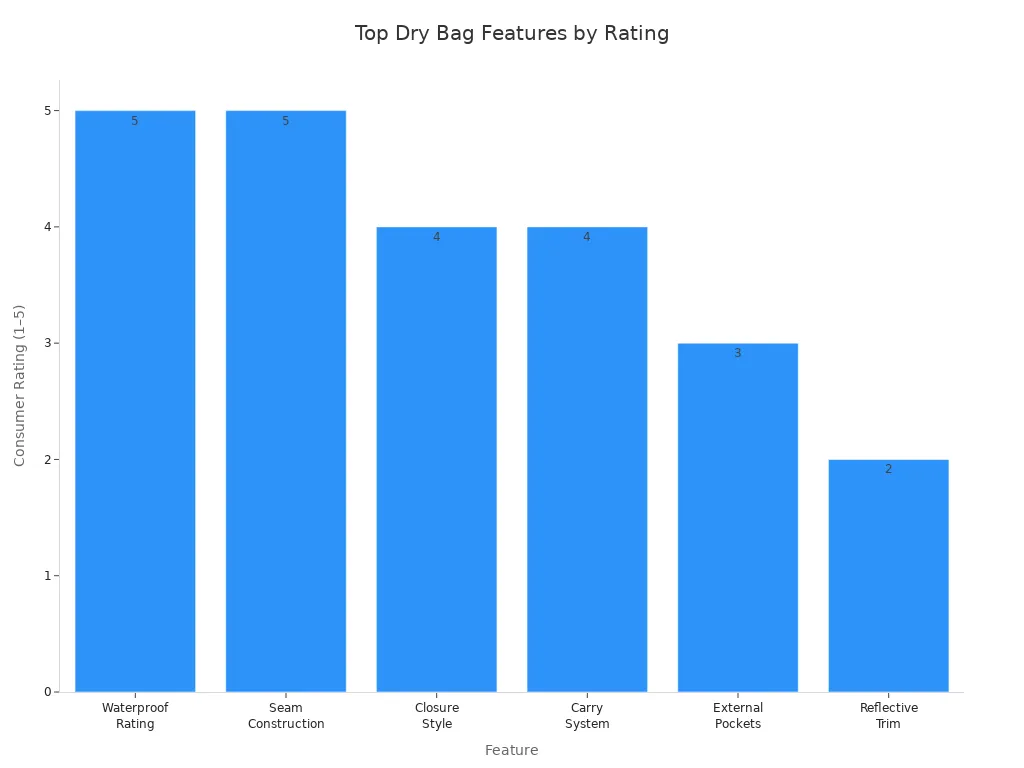
You want a dry bag that matches your activity and gives you the best performance. If you hike, paddle, or travel, you need a bag that keeps water out and feels good to carry. The right dry bag styles help you stay organized and protect your gear.
Key Features (Straps, Windows, Pockets)
When you look at dry bags, you see many features that boost performance. Straps make it easy to carry your bag on your back or shoulder. Some bags have padded straps for extra comfort. Windows let you see inside without opening the bag. This saves time and helps you find things fast. Pockets give you quick access to small items like keys or snacks. You don’t need to open the main compartment every time.
Here are some features you might want:
- Adjustable straps for comfort
- Clear windows for easy viewing
- External pockets for fast access
- Reflective trim for safety at night
Tip: If you want better performance, pick a dry bag with straps and pockets. You will carry your gear more easily and find things faster.
Organization & Easy Access
You can organize your gear with different dry bag styles. Bags come in many sizes and colors. You use small bags for electronics and bigger ones for clothes. Color coding helps you spot your gear quickly. You don’t waste time searching for what you need. This makes packing and unpacking much easier.
- Use different colors for each type of gear
- Pack small items in small bags
- Choose clear windows for fast identification
You get better performance when you organize your gear. You spend less time looking for things and more time enjoying your adventure. Dry bags with smart features help you stay ready for anything.
Note: Organized dry bags mean less stress and better performance outdoors. You keep your gear safe, dry, and easy to reach.
Materials & Construction
When you pick a dry bag, you want to know how well it keeps water out and how long it will last. The secret lies in the material, the way the seams are made, and the type of closure. Let’s break down what you need to know about each part.
Waterproof Materials (Nylon, Vinyl, PVC)
The material of your dry bag decides how waterproof it is. Some materials work better than others. You might see nylon, vinyl, PVC, TPU, or polyester when you shop for dry bags. Each one has its own strengths. Here’s a quick dry bag material comparison to help you choose:
| Material | Waterproof Rating |
|---|---|
| TPU | IPX8 |
| PVC | Above 5,000 mm |
| PU-coated Nylon | Excellent |
| Ripstop Nylon | Needs special coating |
| Polyester | Moderate |
You want a dry bag that uses a waterproof material. TPU and PVC give you the best protection. PU-coated nylon also works well. Ripstop nylon needs a coating to be fully waterproof. Polyester offers some water resistance but not as much as the others. Always check the label for the waterproof rating before you buy.
Tip: If you plan to use your dry bag in heavy rain or water sports, pick a bag with a high waterproof rating.
Seams & Closures
The way a dry bag is put together matters as much as the material. Seams and closures keep water from sneaking in. You want to look for these features:
- Fully welded seams give you the strongest and most waterproof construction. They last longer than sewn-and-taped seams.
- A roll-top closure, like the DrySeal™ system, makes it easy to get a tight, simple seal every time.
You should always check the seams and closure before you trust your bag in wet conditions. A good closure keeps your gear dry, even if you drop the bag in water. Welded seams add extra waterproof strength.
Note: A dry bag with welded seams and a roll-top closure gives you the best waterproof protection.
Durability & Weight
You want your dry bag to last for years. The material you choose affects both durability and weight. Some materials are tough but heavy. Others are light but may wear out faster. Here’s what you need to know:
- The lifespan of a dry bag depends on the material, how often you use it, and where you use it.
- Nylon, PVC, and TPU all offer different levels of durability. Well-maintained bags can last several years.
- New technology helps make dry bags stronger and lighter than ever.
If you use your dry bag a lot or in rough places, pick a thicker material for better durability. If you want to save weight, try an ultra-light bag, but handle it with care. Always think about how you will use your bag before you choose the material.
Remember: The right material and construction keep your gear dry and your bag in good shape for a long time.
Choosing the Right Dry Bag
By Activity (Water Sports, Hiking, Travel)
You want a dry bag that fits your adventure. If you love kayaking, you need kayak dry bags that can handle splashes and even a quick dunk in the water. For hiking, you might want a lightweight bag that keeps your clothes and snacks dry when it rains. Travelers often look for waterproof bags that fit inside suitcases or backpacks.
Here’s a quick guide to help you match dry bag types to your activity:
| Activity | Best Dry Bag Type | Why It Works |
|---|---|---|
| Kayaking | Roll-top, kayak dry bags | Waterproof, floats, easy to secure |
| Hiking | Dry bag backpack | Comfortable straps, waterproof, easy to carry |
| Travel | Duffel dry bag | Large capacity, easy to organize and access |
- Roll-top dry bags work well for paddling and come in many sizes.
- Dry bag backpacks help you carry lots of gear on long hikes.
- Duffel dry bags make it easy to pack for longer trips and find your things fast.
Tip: Always check if your dry bag is truly waterproof before you head out. You want your gear to stay dry, no matter what.
By Size & Capacity
Picking the right capacity makes packing much easier. If you only need to carry your phone, wallet, or camera, a small bag (5-15 liters) is perfect. For a day on the water or a short hike, this size keeps your essentials safe and dry. If you plan a longer trip, you need more space for clothes, food, and gear.
Here’s a table to help you choose the right capacity for your trip:
| Size Range | Recommended Use |
|---|---|
| 5L to 15L | Day trips, snacks, phones, cameras |
| 16L to 30L | Kayak dry bags, small gear bags on rafts |
| 30L to 50L | Single-night trips, gear for rafts or SUPs |
| 50L to 110L | Multi-day rafting trips, personal gear for expeditions |
Choosing the right size helps you stay organized. Smaller bags are great for electronics and valuables. Larger bags hold clothes and bigger items. This makes packing for multi-day trips much easier and keeps your gear sorted.
Note: If you use several dry bags with different capacities, you can separate wet and dry items or keep your gear organized by type.
By Features & Preferences
You have lots of choices when it comes to features. Some dry bags have padded straps for comfort. Others have clear windows so you can see what’s inside. You might want extra pockets for small items or reflective strips for safety at night. Think about what matters most to you.
- Do you need a bag that floats? Look for inflatable or roll-top styles.
- Want to carry heavy loads? Pick a dry bag backpack with strong straps.
- Need quick access? Try a zippered or clamshell dry bag.
Waterproof protection is the most important feature. You also want a bag with good durability, so it lasts through many trips. If you use your bag often, check the seams and closures for signs of wear. A strong, waterproof bag with the right capacity and features will keep your gear safe and make your adventure more fun.
Remember: The best dry bag is the one that fits your activity, holds all your gear, and matches your style.
Care & Maintenance
Taking care of your dry bag helps you get the most out of its waterproof protection and keeps it working for years. You don’t need fancy tools or special skills. Just follow a few simple steps, and your bag will stay ready for every adventure.
Cleaning & Storage
You want your dry bag to last as long as possible. Cleaning and storage play a big part in keeping it in good shape. Here’s what you can do:
- Turn your dry bag inside out and let it air-dry in a well-ventilated spot. Keep it away from direct sunlight because UV rays can damage the material and reduce durability.
- Store your dry bag in a cool, dry place. Avoid tight compression or sealed containers. This stops moisture from building up and keeps the waterproof coating strong.
- Never leave your dry bag outside for long periods. Sunlight can fade colors and weaken the waterproof layer.
- If your bag gets dirty, rinse it with fresh water and let it dry completely before putting it away.
- Proper care can make your dry bag last for decades. Some bags have lasted over 35 years with good cleaning and storage habits.
Tip: Always check your dry bag for damp spots before putting it in storage. A dry bag that stays dry inside and out will keep its waterproof power and durability much longer.
Repair Tips
Sometimes your dry bag gets a small puncture or a seam starts to leak. You don’t have to throw it away. You can fix most problems with a few easy steps. Here’s how you can repair your dry bag:
- Clean the damaged area to remove dirt or oils.
- Use sandpaper to roughen the surface. This helps the glue stick better.
- Apply adhesive designed for waterproof materials like TPU or nylon.
- Align the edges and hold them together until the glue cures.
- For quick fixes, use self-adhesive repair patches or waterproof tape. Cut the patch a little bigger than the hole and press it down firmly.
- You can add seam sealer around the patch for extra durability.
Note: Always let the adhesive or patch set according to the instructions. This keeps your dry bag’s waterproof seal strong and helps maintain durability.
When to Replace
Even with good care, every dry bag reaches the end of its life. You want to know when it’s time for a new one. Here are signs you should look for:
| Sign of Wear | What It Means |
|---|---|
| Cracked waterproof coating | Bag may leak, less protection |
| Sticky or peeling seams | Loss of durability, risk of leaks |
| Persistent leaks | Waterproof seal is gone |
| Faded or brittle material | UV damage, less flexibility |
| Mold or bad odor | Poor storage, hard to clean |
If you see any of these problems, your dry bag may not keep your gear dry anymore. A new dry bag gives you better waterproof protection and peace of mind. You don’t want to risk your electronics or clothes with a worn-out bag.
Emoji: Regular cleaning, smart storage, and quick repairs keep your dry bag working well. When you spot serious damage, it’s time to upgrade for better durability and waterproof safety.
Quick Comparison & Decision Guide
At-a-Glance Table
You want to pick the right dry bag without getting lost in details. Here’s a simple table to help you compare the main types. You can see which style fits your needs best.
| Dry Bag Type | Closure | Waterproof Level | Best For | Extra Features |
|---|---|---|---|---|
| Roll-Top | Roll-top | Excellent | Kayaking, hiking | Floats, easy to seal |
| Zippered | Zipper | Good | Travel, beach | Quick access, pockets |
| Clamshell | ZipDry/Zipper | Excellent | Photography, boating | Wide opening, organized |
| Hybrid | Roll-top | Excellent | Multi-use, camping | Windows, insulation |
| Inflatable | Roll-top | Excellent | Water sports | Floats, pillow option |
| Ultra-Light | Roll-top | Good | Backpacking, hiking | Lightweight, compact |
| Backpack | Roll-top | Excellent | Hiking, travel | Padded straps, pockets |
| Specialty | Varies | Excellent | Electronics, medical | Padding, custom fit |
Tip: Always check the waterproof rating before you buy. Some bags work better for heavy rain or full submersion.
How to Decide
Choosing a dry bag can feel tricky. You want to make sure your gear stays dry and safe. Here are some things to think about when you compare options:
- Look for strong materials and welded seams. These give you better waterproof protection and help your bag last longer.
- Think about extra features. Pockets, carrying straps, D rings, and reflective prints make your bag easier to use and safer at night.
- Ask yourself how you plan to use the bag. Will you take it kayaking, hiking, or just to the beach? The intended use helps you pick the right style.
- Consider how you will organize your gear. Some bags have clear windows or extra pockets for small items. This makes packing and finding things much easier.
- Choose the right size. If you only need to carry a phone and wallet, a small bag works well. For longer trips, you need more space for clothes and food.
You want a dry bag that matches your adventure. If you hike in the rain, pick a backpack style with padded straps. If you paddle on a lake, choose a roll-top bag that floats and seals tight. For travel, zippered bags give you quick access and help organize your things.
Note: The best dry bag keeps your gear dry, feels comfortable to carry, and fits everything you need. Always test the waterproof seal before you head out.
You can use these tips and the table above to make a smart choice. Pick a dry bag that gives you peace of mind and lets you enjoy your trip without worry.
Conclusion
You’ve seen how each dry bag type fits a different adventure. Roll-top bags work for paddling. Backpacks help on hikes. Specialty bags protect your electronics. Always match your bag’s style and features to your plans. Think about material, closure, and size before you buy.
Need something special? We offer OEM, ODM, and custom dry bag solutions. Reach out to us for your perfect dry bag!
FAQ
What size dry bag should you choose for a day trip?
You want a dry bag between 10 and 20 liters for a day trip. This size fits snacks, a phone, and a change of clothes. If you pack light, a smaller bag works well.
Can you fully submerge a dry bag in water?
Most dry bags handle brief submersion. You should check the closure and seams before you trust it underwater. For deep or long submersion, look for bags with high waterproof ratings.
How do you clean your dry bag after use?
Rinse your dry bag with fresh water. Turn it inside out and let it air dry. Keep it away from direct sunlight. This helps your bag last longer.
Are dry bags safe for electronics?
Yes, dry bags protect electronics from water, dust, and dirt. You should double-check the seal before you pack your phone or camera. For extra safety, use a padded or specialty dry bag.
Can you use a dry bag as a backpack?
You can use dry bag backpacks for hiking, travel, or water sports. These bags have padded straps and extra pockets. They keep your gear dry and feel comfortable to carry.
What is the difference between a dry bag and a dry sack?
A dry bag uses thicker material and stronger closures. It works for water sports and rough use. A dry sack is lighter and better for organizing gear inside another bag.
How long does a dry bag last?
With good care, your dry bag can last for years. Clean it often and store it in a cool, dry place. If you see cracks or leaks, it’s time to replace it.
Tip: Always test your dry bag before your trip. Put tissue paper inside, seal it, and dunk it in water. If the tissue stays dry, your bag is ready!


